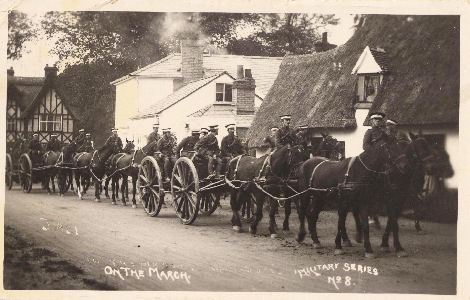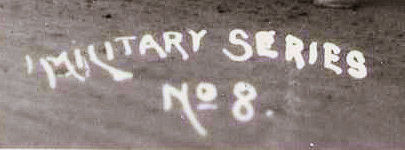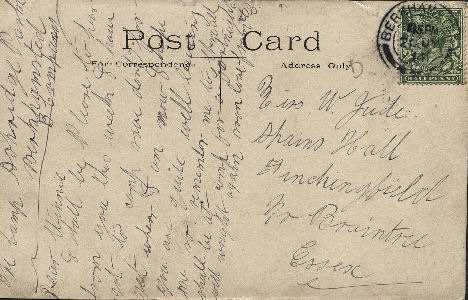|
|
Territorial Training Camp, Ashridge, July 1914 September, 2010 |
|

Robenn Lloyd (rlloyd @t supanet.com) had read the section of my book The London Gunners come to Town which describes the Ashridge training camp in July 1914 and wrote to ask if I could identify the picture of troops in the above picture, which was clearly sent from someone at the camp.
A General Comment about Event Post Cards in the early 20th century
It is more useful to compare the photograph with those produced for other events (both military and non-military) at the time, including those produced after the war had broken out. The papers still had very few photographs and while some people had simple roll film cameras, most did not. In some cases of all day events the photographer may have turned up at the start, taken some photographs, rushed back to the lab, developed the plates or negatives and printed off copies which would be rushed back to the event so people could buy on the spot or order copies before they left. In other cases they may have been available for view from the photographer's shop the following day. During the Second World War my father had a shop where, if my vague childhood memory is correct, the local photographer displayed pictures of the troops in the local training camps so that the soldiers could order "personal" postcards to send to friends at home. (I think these showed the soldiers marching from the station to the camp - so they could send home pictures of their unit, with some individual soldiers - perhaps even themselves - being identifiable.)
The small and short lived market means that event post cards are almost all real photographs - although there was one photographer (Downer) at Watford which produced printed event cards in the first few years of the century. To ensure the orders were correctly executed each negative was numbered, and often the name/date of the event was added. To maximise re-orders the photographer would take care to ensure that his name appeared somewhere. Sometimes it was written on the negative, sometimes it was stamped or printed on the address side card, and sometimes it was embossed in a corner of the picture. If an event card has no number and no photographer identification it could well be an amateur photo - as in the case of The Funeral.
But what would you do if you wanted to send a card showing what you had been up to and there were no suitable event cards available, or they were too expensive. You would send a nicely anonymous theme card related to the situation. If you were a fisherman who had just caught a large pike in Hertfordshire a postcard showing a delighted fisherman with a huge fish would be perfectly acceptable if it had the title "The one that didn't get away" but not is if had the title "The salmon John Smith caught in the River Seven in 1905". There were a large number of theme cards to meet this market - which have a deliberately general title and were very careful to not to restrict the market by identifying who is in the picture or where and when it was taken. Because collecting post cards was all the rage many were issued in numbered series in the hope that people would try and collect the set. Most were printed (because they sold in larger numbers all over the country), and quite a few were drawings or paintings. However some smaller publishers might issue such cards as real photographs. As long as they are suitably anonymous some event photographs could be used as theme cards.
An analysis of the card
 I
am sure you now know the direction I am going. The card carefully does not
identify the troops, or where and when it was taken, and the title "On the
March" makes it suitable for anyone in the army to send to anyone when they
have themselves been "on the march". Who is going to worry that the
picture shows soldiers riding on a limber and caisson, suggesting to the
knowledgeable that they are in the artillery, when the sender is attending
an infantry training camp. As neither the sender or the recipient may know
the area around Berkhamsted, who is going to worry where the picture was
taken, or when. It is even in a nicely numbered "why don't you collect the
others" series. I can see no reason to associate the picture with the
Ashridge camp in July 1914.
I
am sure you now know the direction I am going. The card carefully does not
identify the troops, or where and when it was taken, and the title "On the
March" makes it suitable for anyone in the army to send to anyone when they
have themselves been "on the march". Who is going to worry that the
picture shows soldiers riding on a limber and caisson, suggesting to the
knowledgeable that they are in the artillery, when the sender is attending
an infantry training camp. As neither the sender or the recipient may know
the area around Berkhamsted, who is going to worry where the picture was
taken, or when. It is even in a nicely numbered "why don't you collect the
others" series. I can see no reason to associate the picture with the
Ashridge camp in July 1914.

It is perhaps worth commenting on the writing. It would appear that initially the negative was labelled with the untidily written words "On the March xxxx" where "xxxx" is now unreadable. This was incompletely removed and the negative relabelled "On the March" in a tidier hand. Some marks which might be interpreted "J A" elsewhere on the card may just be ink residue displaced in the badly done cleaning process. It is not clear whether the first set of writing was removed because it was sub-standard or whether the picture had been issued earlier (perhaps as an event card) and then re-titled as a general purpose theme card.

There seems little doubt that the writing on the back is directly connected with the fateful army camp on Ashridge where they all set out for fortnight's fun-filled training "jolly" and ended up fighting for real in France. I know that "B" Company of the 1st Battalion, Hertfordshire Regiment, (from St Albans) was at the camp at the end of July, 1914, but also that "F" company didn't go to the camp until 26th July while the card was posted on the 20th. However different Regiments were there at different overlapping dates, with some being there before the Hertfordshire Regiment. In total there were some 4000 men in camp from the East Midland Brigade - and other troops came from Cambridgeshire, Bedfordshire and Northamptonshire. As the sender did not think to identify which, he may well have been in the first "B" Company to arrive at Ashridge. On the other hand the spelling errors in the text could suggest a comparatively low level of writing skills.
The soldier was probably writing to Miss Winifred Jude (aged about 16) who in the 1901 census was 3 years old and living with her parents in Islington, London. Neither she, or her parents had any obvious connection with Hertfordshire.

